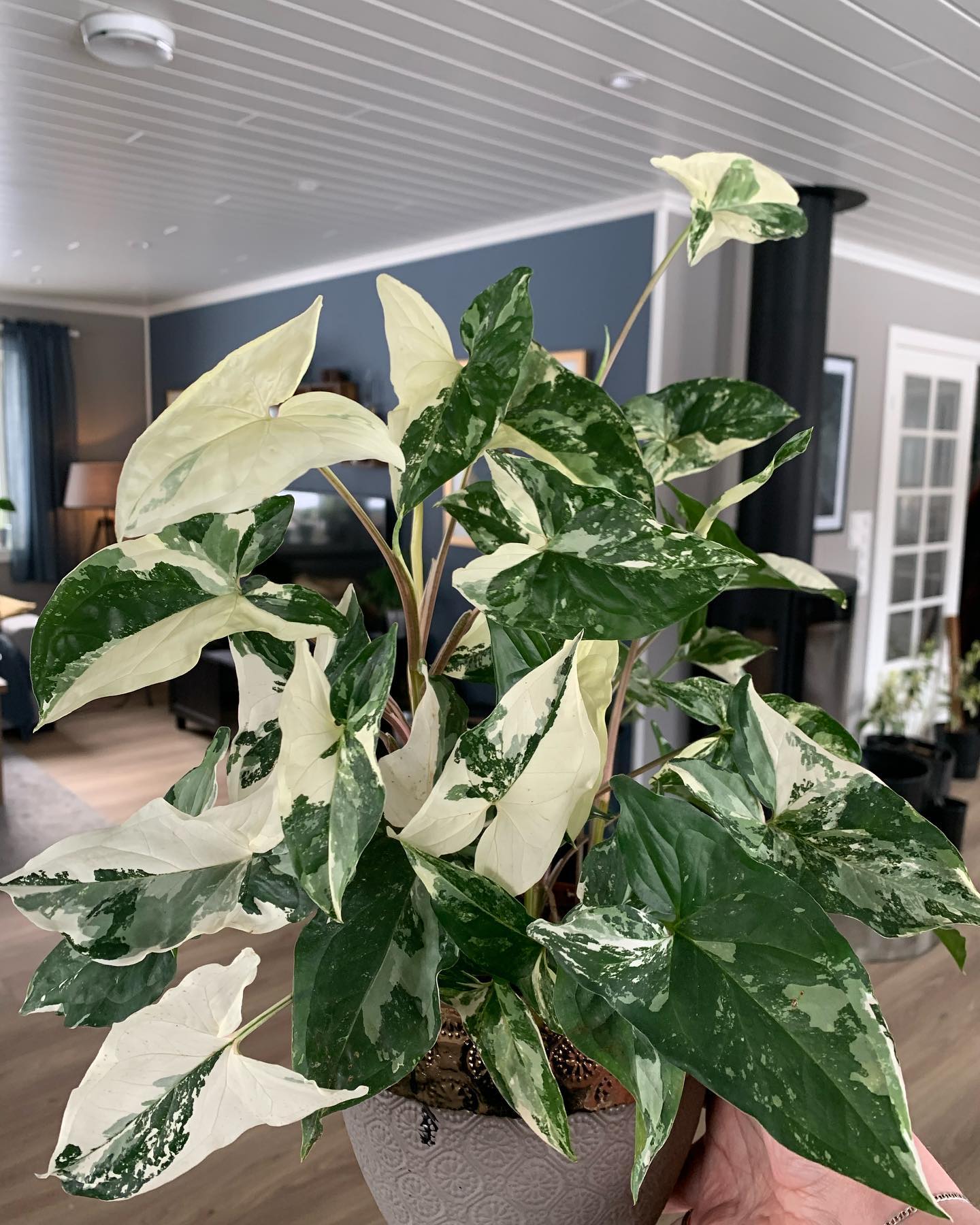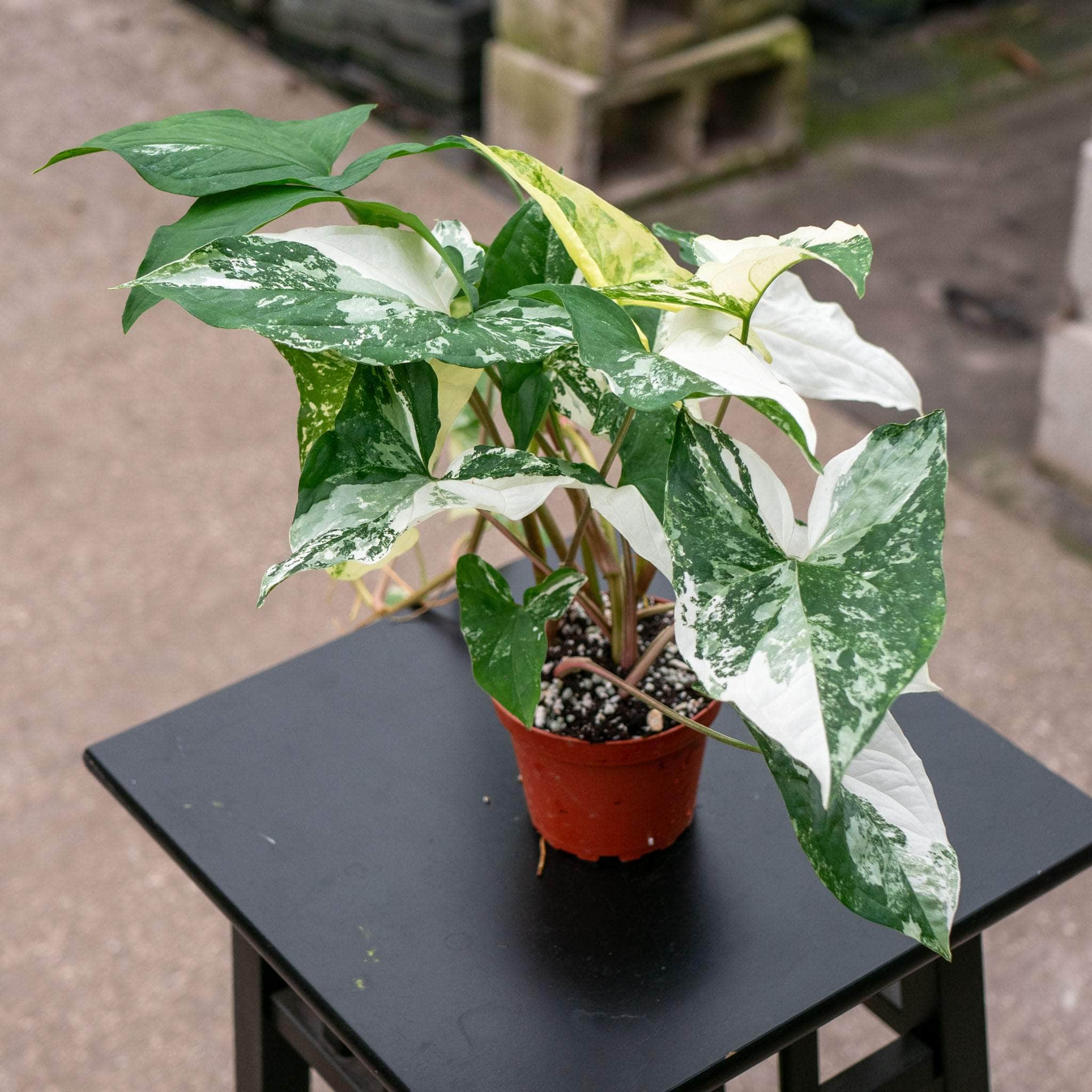Absolutely! Here’s a 3000-word article about Syngonium Albo, formatted with `
` and `
` tags instead of “.
Syngonium Albo, with its striking variegated leaves, has captivated plant enthusiasts worldwide. This rare and sought-after aroid is a testament to nature’s artistry, showcasing a stunning contrast between deep green and pure white. This comprehensive guide delves into the intricacies of Syngonium Albo, covering its origins, characteristics, care requirements, propagation methods, and common issues.
Origins and Characteristics
Syngonium Albo, scientifically known as Syngonium podophyllum ‘Albo Variegatum’, is a cultivar of the arrowhead plant. Its origins trace back to the tropical rainforests of Central and South America. This plant is renowned for its unique variegation, where each leaf displays a random pattern of white or cream sections against a dark green backdrop.
Variegation Patterns

The variegation in Syngonium Albo is due to a genetic mutation that prevents certain cells from producing chlorophyll. This results in the white or cream areas, which lack the ability to photosynthesize. As a result, the green portions of the leaf must work harder to provide the necessary energy for the plant. The patterns are unpredictable, with each new leaf offering a unique display. Some leaves may be predominantly white, while others feature subtle streaks and splashes.
Growth Habits
Syngonium Albo is a climbing vine in its natural habitat, using aerial roots to attach itself to trees and other supports. In indoor settings, it can be trained to climb a moss pole or allowed to trail gracefully from a hanging basket. The leaves start off as arrow-shaped when young and mature into a more lobed form as the plant ages.
Rarity and Value
Due to its slow growth rate and the difficulty in propagating plants with high variegation, Syngonium Albo is considered a rare and valuable plant. The more white variegation a plant exhibits, the higher its market value tends to be.
Care Requirements
Caring for Syngonium Albo requires a delicate balance of light, water, and humidity. Understanding these needs is crucial for maintaining the plant’s health and vibrancy.
Light

Syngonium Albo thrives in bright, indirect light. Direct sunlight can scorch the leaves, especially the white portions, which are more susceptible to damage. An east or north-facing window is ideal. Insufficient light can lead to reduced variegation and leggy growth.
Watering
Watering should be done when the top inch of soil feels dry. Overwatering can lead to root rot, a common problem for this plant. Ensure the pot has adequate drainage to prevent waterlogging. During the winter months, reduce watering frequency as the plant’s growth slows down.
Humidity
High humidity is essential for Syngonium Albo. Aim for humidity levels between 60-80%. This can be achieved by using a humidifier, placing the plant on a pebble tray with water, or grouping it with other humidity-loving plants. Misting the leaves can also help, but ensure good air circulation to prevent fungal issues.
Soil and Fertilization
A well-draining potting mix is crucial. A blend of perlite, orchid bark, and coco coir is ideal. Fertilize the plant every 4-6 weeks during the growing season (spring and summer) with a balanced liquid fertilizer diluted to half strength. Avoid fertilizing during the winter months.
Temperature
Syngonium Albo prefers warm temperatures between 65-80°F (18-27°C). Avoid exposing the plant to temperatures below 55°F (13°C), as this can cause damage.
Propagation Methods
Propagating Syngonium Albo can be challenging due to its slow growth and the need to preserve the desired variegation.
Stem Cuttings
The most common method of propagation is through stem cuttings. Select a healthy stem with at least one node and several leaves. Cut the stem just below a node. Place the cutting in water or a moist potting mix, ensuring the node is submerged. Roots should develop within a few weeks.
Air Layering
Air layering is another effective method, especially for larger plants. Select a healthy stem and make a small cut halfway through the stem. Wrap the cut area with moist sphagnum moss and cover it with plastic wrap. Once roots develop, cut the stem below the rooted area and pot it.
Tissue Culture
For commercial propagation, tissue culture is used to produce large quantities of plants. This method involves growing plantlets in a sterile laboratory environment.
Challenges in Propagation
Maintaining the variegation in propagated plants can be challenging. Cuttings taken from highly variegated plants may not always produce new growth with the same level of variegation. Patience is key, as it can take time to see the results.
Common Issues and Solutions
Syngonium Albo, like any plant, can encounter various issues. Understanding these problems and their solutions can help maintain a healthy plant.
Root Rot
Root rot is a common problem caused by overwatering. Symptoms include yellowing leaves, wilting, and a foul odor from the soil. To prevent root rot, ensure the soil is well-draining and allow it to dry slightly between waterings. If root rot occurs, remove the affected roots and repot the plant in fresh soil.
Pest Infestations
Common pests include spider mites, mealybugs, and aphids. Regularly inspect the plant for signs of infestation. Treat infestations with insecticidal soap or neem oil.
Leaf Browning
Leaf browning can be caused by various factors, including low humidity, insufficient watering, and exposure to direct sunlight. Adjust the care routine accordingly.
Reduced Variegation
Insufficient light can cause the plant to produce more green leaves and less white variegation. Ensure the plant receives adequate bright, indirect light.
Slow Growth
Syngonium Albo is naturally a slow grower. However, extremely slow growth can indicate a lack of nutrients. Fertilize the plant during the growing season to promote healthy growth.
Enhancing Variegation
Maximizing the variegation in Syngonium Albo is a common goal for many plant enthusiasts.
Optimal Lighting
Providing bright, indirect light is crucial for maintaining and enhancing variegation. Insufficient light will lead to more green growth.
Selective Pruning
Pruning can encourage the plant to produce new growth with higher variegation. Remove leaves that are predominantly green to encourage the plant to focus its energy on producing variegated leaves.
Genetics
The level of variegation is largely determined by the plant’s genetics. Plants with a high degree of variegation are more likely to produce offspring with similar characteristics.
Displaying Syngonium Albo
Syngonium Albo can be displayed in various ways to showcase its beauty.
Hanging Baskets
Hanging baskets allow the plant’s trailing vines to cascade gracefully, creating a stunning display.
Moss Poles
Moss poles provide support for the plant to climb and encourage the development of larger, more mature leaves.
Decorative Pots
Choosing a decorative pot that complements the plant’s variegation can enhance its visual appeal.
Terrariums
Syngonium Albo can also thrive in terrariums, where the high humidity levels create an ideal environment.
The Allure of Syngonium Albo
Syngonium Albo’s unique variegation and rarity make it a prized possession for plant collectors. Its ability to transform any space into a lush, tropical oasis is undeniable.
A Collector’s Item
The rarity and high demand for Syngonium Albo have made it a sought-after collector’s item. Plant enthusiasts are often willing to pay a premium for plants with exceptional variegation.
A Statement Plant
Syngonium Albo’s striking appearance makes it a statement plant that can elevate the aesthetic of any room.
A Living Artwork
Each leaf of Syngonium Albo is a unique work of art, displaying a random and captivating pattern of green and white.
A Symbol of Growth
The plant’s climbing nature and its ability to adapt to indoor environments symbolize growth and resilience.
In conclusion, Syngonium Albo is a captivating plant that requires careful attention to thrive. By understanding its origins, care requirements, and propagation methods, enthusiasts can enjoy the beauty of this rare and exquisite aroid. Its unique variegation and elegant growth habits make it a cherished addition to any plant collection.

